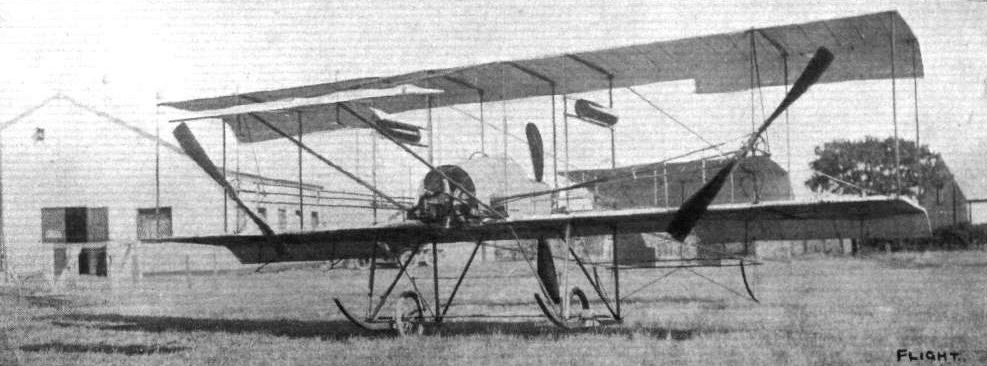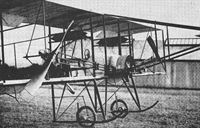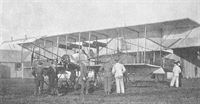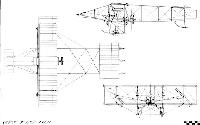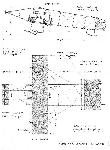C.Barnes Short Aircraft since 1900 (Putnam)
Short Twin-Engined Biplanes (1911-13)
Short Brothers were not the originators of the twin-engined aeroplane, as has sometimes been claimed, for both Hiram Maxim in 1894 and Clement Ader in 1897 had used two steam engines, because they needed twice the output of the only available power units; for the same reason Col Capper installed two 12 hp Buchet engines in the Dunne D.4 in 1908 and J. W. Seddon used two N.E.C.s in his fantastic steel-tube tandem biplane in 1910; neither of these left the ground, but on 27 September, 1910, Roger Sommer made the first successful twin-engined flight in a biplane of his own design. About the same time Horace Short, in his search for better controllability at low speeds, conceived the idea of placing all the control surfaces in the slipstream and took out a master patent, No. 1,223 of January 1911, covering all practicable arrangements, including outboard airscrews in front of the ailerons and a central airscrew or propeller ahead of the tail surfaces. As a first application of the principle, he designed and built a variant of the S.27-type with two engines which could be shut down independently; this biplane, S.39, could maintain flight on either one of its two engines and was thus the first example in the world of twin engines being used to enhance safety.
S.39 was structurally the same as the improved Farman-Sommer-type Short biplane of 1911 apart from the nacelle and power plant arrangement; it had a stronger chassis laterally braced by struts, three rudders below the tailplane and a front elevator carried on inset pivots by booms pitched closer together than normal. The nacelle contained a cockpit with two seats side-by-side and carried a 50 hp Gnome engine and propeller on a standard overhung pusher mounting at the back; another 50 hp Gnome was mounted at the front, rotating in the opposite direction so that gyroscopic moments cancelled out when both engines were running. The forward engine drove two wing-mounted tractor airscrews through Wright-type Renold chain gears, the port chain being crossed to obtain counter-rotation, and the ‘bent-end’ airscrews were exactly like those made for the Short-Wright biplanes. S.39, known as the Triple-Twin, was first flown on 18 September, 1911, by Frank McClean; he made a brief solo flight, then, with Samson as passenger, flew eight wide circuits of Eastchurch aerodrome, throttling back each engine in turn and experiencing for the first time the luxury of an ample speed range while flying a level course. The effect of the outboard slipstream on lateral control was not up to Horace Short’s expectations, but he was pleased with the Triple-Twin’s overall performance and next decided to try the effect of co-axial counter-rotation on stability. The first step was to convert Cecil Grace’s old S.27 to a similar twin-engined layout, but with the front engine direct-coupled to an airscrew, as shown in patent No. 22,675 of 1911.
This version was called the Tandem-Twin, or, less formally, the Gnome Sandwich, and retained the original S.27 wings and cambered tail unit unchanged except for the addition of two extra top rudders. The chassis was strengthened in the same way as for S.39, and the existing front elevator and booms were retained, since they allowed adequate clearance for the central airscrew. The Tandem-Twin was flown by McClean on 29 October, 1911, without any preliminary taxying; after a short flight at 100 ft he landed and expressed even more satisfaction than with the Triple-Twin; he spent the rest of the day taking up various passengers to test their reactions to the slipstream and to the location of the rear propeller only 10 in behind their heads. The draught in the cockpit was quite powerful and the Tandem-Twin soon acquired yet another soubriquet - The Vacuum Cleaner - and was credited with the ability ‘to pull the hairs out of a fur coat’; this was mainly due to the open hole in the floor, which was the only means of access. The Tandem-Twin could maintain height with either engine throttled back, but was unstable in every direction, due to insufficient aileron power and to unpredictable variations in torque reaction with the rear propeller working in the wake of the front one. Horace Short investigated this effect very thoroughly and deduced design rules for the relative diameters and pitches of tandem airscrews which were still valid 20 years later.
He also designed a larger biplane with two central engines of 120 hp each, driving four propellers arranged in tandem pairs in the wings, with independent chain gears for the front and rear engines. He obtained a number of patents (Nos. 8,108, 8,394 and 22,750 of 1911) for co-axial and interconnected airscrews, but the four-screw aeroplane was never built; however, Maurice Egerton apparently had his S.35 biplane converted into a Triple-Twin and flew it regularly from April 1912 onwards. Both S.39 and S.27 were flown at first without wing extensions, and on 21 November, 1911, they were raced by Longmore and Gerrard respectively; both did better than 55 mph, but S.39 seemed to have the edge over S.27. In December, S.39 was fitted with extensions and double fuel capacity; in February 1912, S.39’s extensions were removed and fitted to S.27, and in October 1912, S.39 was temporarily given equally extended upper and lower wings of 50 ft span, which further top extensions later increased to 64 ft. S.39 was purchased by the Admiralty in June 1912 and given serial T3, later simplified to 3; in the spring of 1913 it was returned to the works for overhaul and completely remodelled as a two-seat tandem pusher with new wings and no front elevator, as already described. The Admiralty declined to buy the Tandem-Twin, which remained McClean’s property (it was No. 11 in his private fleet list), but he lent it to the Naval Flying School without charge, and it was eventually crashed by Samson; Egerton’s S.35 appears to have been dismantled and probably formed the basis of one of the Sociables of early 1914. The final development of the triple-twin theme was the Triple-Tractor S.47, which is described in a later chapter.
Triple-Twin - Span 34 ft (103 m), later 50 ft (15-3 m); length 45 ft (13-7 m); area 435 sq ft (40-4 m2), later 500 sq ft (46-5 m2); empty weight 1,800 lb (816 kg); loaded weight 2,100 lb (953 kg); speed 55 mph (88-6 km/h).
Tandem-Twin - Span 34 ft 2 in (10-4 m), later 50 ft (15-3 m); area 480 sq ft (44-6 m2), later 517 sq ft (48 m2); otherwise as for Triple-Twin.
Short Pusher Biplanes (1910-14)
<...>
Two other types of pusher biplane deserve notice. One was a startling metamorphosis of the original Triple-Twin, S.39, which reappeared on test by Sydney Pickles on 24 July, 1913, as a neat two-seat tandem pusher without a front elevator. It had constant-chord wings of improved profile with struts of oval steel tube and the landing gear and tail unit of a late production S.38-type, with balanced rounded rudders; it still retained its original serial 3, which was almost its only link with the past. Lighter in weight than a standard S.38-type, it had a very lively performance, with a top speed of 65 mph and the then exceptional rate of climb of over 600 ft/min; its ceiling was better than 9,000 ft. It was a favourite mount of Samson’s, and he used to fly it at night; he took Winston Churchill up in it during his visit to Eastchurch on 24-25 October, 1913. Finally, it joined the scratch squadron which Samson took to Flanders early in the war and was based at Poperinghe in October 1914, but was never armed and only used as a communications hack.
<...>
S.39 (rebuilt) - Span 52 ft (15-84 m); length 29 ft (8-85 m); area 500 sq ft (46-5 m2); empty weight 1,000 lb (454 kg); loaded weight 1,500 lb (680 kg); speed 65 mph (104-6 km/h).
Показать полностью
M.Goodall, A.Tagg British Aircraft before the Great War (Schiffer)
Deleted by request of (c)Schiffer Publishing
S27. Tandem Twin biplane
Although a major reconstruction was carried out to S27 to fit a second engine, this machine received no separate construction number. The aircraft was built to investigate the effect of rotating airscrews on stability and control and was the subject of patent No.22675/1911 by Horace Short. The first flight took place on 29 October 1911 by McClean, who acquired this as McClean No. 11, as well as many of the early Short aircraft. The Tandem Twin was loaned to the Navy for instructional use from December 1911, but was crashed on 11 March 1912 by Lt. Samson. It was identified as Serial No.4 in the first Admiralty series.
The machine was flown both with and without extensions, and the main structure was unchanged apart from strengthening of the undercarriage. A nacelle was added to house the crew side by side, between the two engines, to which access was gained through an aperture in the floor, the draught through which inspired the nickname 'Vacuum Cleaner'. Two extra rudders were added on top of the original cambered tailplane.
Data
Span 34ft 2in (46ft with extensions)
Chord 6ft 9in
Gap 6ft 4in
Area 480 sq. ft (571 sq. ft with extensions)
Weight 1,800lb.
Weight allup 2,100lb.
Speed 55 mph
S39. Triple-Twin tractor/pusher biplane (Refers also to S35 rebuild)
This aircraft was built to test Horace Short's ideas to improve control at low speeds, by designing for slipstream over all control surfaces. The twin engines were also a safety measure, since the aircraft could fly successfully on one. McClean flew the S39 solo for the first time on 18 September 1911 and also with Samson as a passenger the same day. (McClean No. 10).
The aircraft was a strengthened form of earlier Short biplanes, with a central nacelle and side-by-side seating. It was necessary to place the front booms closer together, to provide clearance for the outboard propeller tips; the front elevator consequently extended beyond the booms. The tail booms were parallel in plan and with slight taper towards the tail in elevation. The tailplane, with rear elevator, was mounted on the top booms, with three rectangular rudders trailing behind their last uprights. A strengthened undercarriage with diagonal bracing struts and twin tail skids were fitted.
The wings were originally without extensions, which were added later, and were fitted with single acting ailerons both top and bottom, including to the extensions when these were fitted. The front engine drove the outboard counter rotating tractor airscrews by chains. The rear engine was mounted with the propeller in front on an overhung mounting. Two cylindrical fuel tanks were originally mounted below the top center section, but a further pair were added in December 1911, in similar positions on the next pair of interplane struts at the time when the extensions were first fitted. The extensions were removed in October 1912 and replaced by wings of 50 feet span, these also being fitted with extensions later when the span increased to 64 feet.
The Admiralty purchased S39 in June 1912; identified as T3, it became No.3 later. The machine was entirely rebuilt under Short's No.S78, as a single engined, tandem seated pusher with either 70 or 80hp Gnome. From June 1913 it was used by the Navy, including wartime service in France, until finally discarded in April 1916.
A second Triple Twin was constructed from S35 for the Hon. Maurice Egerton and was flown from April 1912 and may have been rebuilt itself by early 1914.
Power: Two 50hp Gnome seven-cylinder air-cooled rotaries driving two 8ft 6in diameter tractor propellers by chain and one 8ft 6in diameter pusher propeller direct.
Data
Span 34ft later 50ft and 64ft
Chord 6ft 9in
Gap 6ft 4in
Area 435 sq. ft later 650 sq. ft and 745 sq. ft
Area tailplane 65 sq. ft
Area front elevator 29 sq. ft
Area rear elevator 29 sq. ft
Area rudders 45 sq. ft
Length 45ft
Height 12ft
Weight 1,800 lb.
Weight allup 2,100lb.
Speed 55mph
Показать полностью
P.Lewis British Aircraft 1809-1914 (Putnam)
Short Tandem Twin
The Tandem Twin of 1911 was known colloquially as the "Vacuum Cleaner", owing to the draught created by its pair of 50 h.p. Gnomes, or the "Gnome Sandwich", because the side-by-side pilot and passenger were seated between the engines. The tractor-pusher machine was Short No. 17 and was built for F. K. McClean, who gave it his private number 11. The Tandem Twin and Triple Twin were the outcome of Horace Short's belief in obtaining plenty of power for his aeroplanes by employing more than one engine. In essence, they were direct developments of the S.27 design and were the first multi-engined machines built in Great Britain and probably the first in the world. The Tandem Twin was bought daring late 1911 by the Admiralty and was used for training naval pilots at the Eastchurch flying-school under its Admiralty number 27. Span, 50 ft. Length, 45 ft. Wing area, 500 sq. ft. Weight loaded, 2,100 lb. Maximum speed, 55 m.p.h.
Short T.3 Triple Twin
Together with the Tandem Twin, the Triple Twin was one of Horace Short's experiments in multi-engined aeroplanes. It was built during mid-1911 for F. K. McClean, who tested it at Eastchurch in September of the year. In the case of the Triple Twin, the front 50 h.p. Gnome engine drove two tractor propellers by means of long chains, while the rear 50 h.p. Gnome acted as a single pusher. All three propellers were of 8 ft. 6 ins. diameter. The machine seated two. In its original form the wings had an equal span of 34 ft. They were soon increased by extensions to an upper span of 50 ft., resulting at the same time in an increase in area from 435 to 500 sq. ft. At the end of 1911 the Triple Twin was used for the training of naval pilots at Eastchurch, and was later given the designation T.3.
SPECIFICATION
Description: Two-seat tractor-pusher biplane. Wooden structure, fabric covered.
Manufacturers: Short Brothers, Eastchurch, Isle of Sheppey, Kent.
Power Plant: Two 50 h.p. Gnomes.
Dimensions: Span, 34 ft. (later 50 ft.). Length, 45 ft. Wing area, 435 sq. ft. (later 500 sq. ft.).
Performance: Maximum speed, 55 m.p.h.
Short Tractor-pusher Monoplane
The second Short monoplane was constructed during 1912 and was nicknamed the "Double Dirty". Two 70 h.p. Gnome engines were fitted, one in front of the pilot and the other behind him. The machine was fitted w ith inflatable flotation bags to enable it to alight on water, and was tested for the Admiralty in September, 1912, by Cdr. C. R. Samson. R.N.
Показать полностью
O.Thetford British Naval Aircraft since 1912 (Putnam)
SHORT TANDEM TWIN
This aeroplane, with the Triple Twin the first multi-engined aircraft ever built in Great Britain, was purchased by the Admiralty in 1911 and used at the Naval Flying School at Eastchureh. It was converted from a Short S.27 airframe. It had two 50 hp Gnome rotary engines, one driving a tractor and one a pusher airscrew, the pilot being seated between. Maximum speed, 55 mph. Span, 34 ft 2 in. Length, 40 ft 6 in.
SHORT S.39 TRIPLE TWIN
This early Short biplane, also used by the Naval Flying School at Eastchurch from 1911 (RNAS No.3) was powered by two 50 hp Gnome engines. The front engine drove twin airscrews and the rear engine a single pusher. Maximum speed, 55 mph. Span, 50 ft. Length, 45 ft. In July 1913 it was re-built as a two-seater with no forward stabiliser and a single Gnome pusher and went to Belgium in 1914 with Cdr Samson's Eastchurch Squadron.
Показать полностью
Журнал Flight
Flight, September 9, 1911.
THE NEW SHORT BIPLANE.
To design and construct a new biplane fitted with a 100-h.p. plant consisting of two engines and three propellers, is sufficient proof, if any were needed, that Messrs. Short Brothers do not lack enterprise. Moreover, it is evidence that they have the courage of their convictions, for the machine is a full scale experiment intended to test some of their more recent patents. So far as the framework and planes are concerned, the machine adheres more or less closely to the standard practice of the firm, and thus they are following the very proper course of trying out new things on a basic design that they already know something about.
The new feature is the power plant, which consists of two engines placed fore and aft. The forward engine drives two tractor-screws by means of chains, the after engine is direct coupled to a propeller. The combined power of the equipment is 100-h.p., and both engines are intended to be in operation simultaneously. However, the machine is so designed that either one of its engines will be sufficient to keep the machine flying at a speed of about 36 miles an hour, while with both in operation the speed is expected to be somewhere in the neighbourhood of 55 miles an hour. By so equipping the machine with two entirely independent power plants, the risk attending engine failure is almost entirely obviated, for should one peter out, the pilot will be able to proceed unconcernedly by the aid of the other, and leisurely choose a suitable landing place, where he may descend to make any adjustments to his temporarily disabled engine. This is one advantage that the makers claim for the system. Another is, naturally, the enhanced efficiency of the slow-speed tractor-screws driven by the forward motor, but the third claim is the most interesting of all. Messrs. Short Bros, consider that the draught from these tractor screws will be sufficient to establish a permanent uniform "wind" through the gap of sufficient magnitude to blow out any ordinary gust, and that to this extent they will render the machine far more stable in windy weather than would otherwise be the case. Also, it is anticipated that the efficiency of the planes will be enhanced by working in the propeller draught, which will at all times augment the effective flight speed, and an even more important consideration is that the balancers, which are directly in its wake, will be rendered far more sensitive at slow velocities. It has always been argued in connection with the control of aeroplanes by organs like balancers, which themselves derive their force by flying through the air, that their effectiveness varies with the speed of the machine, and is a minimum when the disturbance is likely to be most dangerous. On the new Short biplane, however, these balancers, by operating in the draught of the tractor screws, will have a minimum useful value that is independent of the speed of flight.
Although these are not all the points that Messrs. Short Bros, are seeking to investigate in their new biplane, they must suffice for the moment, and they are, in any case, sufficient to give weight to our statement that the machine in question is one of exceptional interest and does the makers credit. If we turn from the principles to the machine itself, there is one point on which we feel compelled to make an early remark, which is that the structural work has been finished with all the care that one expects on an aeroplane built to order, and but too seldom finds on one that is built for trial purpose, only. It is, however, characteristic of the firm that their experimental work should be of this description, so we need say no more about its
Most of what it is necessary to know about the design and construction of the machine can be seen at a glance by the aid of the accompanying photographs and drawings, and much of the detail that is invisible can be taken for granted by assuming that it is the same as that already described by us in connection with the standard Short models. Two differences that may be noted, however, are the triple rudder and the small span of the elevator outrigger booms, compared with the span of the elevator itself.
Both engines are seven-cylinder rotary Gnomes, and that in front forms as it were the nose of a car, fashioned somewhat, as it appears at first glance, like the outline of a racing automobile. The pilot sits in this car, and there is room for a passenger alongside him, but although the extra seat is not there yet, we have visions of accommodation being provided for two other passengers behind the pilot if the machine proves anything like as successful as is hoped. The aft motor is situated well behind the back of the car, as one of the photographs shows.
The tractor screws are driven by very long chains, running in tubular guides, and rotate in opposite directions, one of these chains being crossed in order to give the necessary reversal of motion. Wright practice is recalled in the use of these steel guide tubes, and in the shape of the tractors themselves; it affords, in fact, a particularly interesting comparison to note the difference in form between the slow-speed propellers in front and the high-speed propeller behind.
In front of the pilot is a wheel mounted on the top of a pivoted column. Turning the wheel operates the balancers, and a to-and-fro motion of the column controls the elevator. Steering is effected by a pivoted cross-bar under the feet, and this mechanism is fitted in duplicate so that the passenger may work in unison with the pilot.
A point that is worth noting is that the fuel tanks are situated as far away from the engines as is practicable, in order to remove as far as possible the liability of serious accident in the event of an atterrissage brusque. They are also fitted with feed pipes of such design as to ensure a constant supply to the carburettor for any attitude that the machine may assume in flight.
So much is, for the moment, all we need say of the new Short biplane, but the fact that it is an experimental machine affords us the opportunity for remarking that it is by no means indicative in itself of the extent of Short Bros.' experimental work, and we should like to congratulate them on this occasion for the thoroughness with which they investigate stresses and strains, and by every means do their utmost to protect the pilot against mechanical failure in flight, for which they very properly say "there is no excuse."
Flight, September 23, 1911.
FROM THE BRITISH FLYING GROUNDS.
THERE is not a great deal to report, but a first trial has been made, as mentioned below, with the new Short double-engined biplane, fully described in the issue of FLIGHT of the 9th inst.
<...>
On Monday Mr. F. C. McClean made the first trial flights in his new Short twin engine biplane, the flights proving very successful, and the machine answering fully the expectations of its constructors. The first trial was made by Mr. McClean alone, who made a short straight flight, in which the machine showed great buoyancy, rising rapidly into the air in spite of the preliminary run being uphill.
Afterwards, with Lieut. Samson on board, Mr. McClean made eight laps of the ground in which he frequently flew with either engine throttled down. A strong feature of the tactics was the large margin of power exhibited by the machine in flight, it being possible to vary the speed considerably, by throttling down either or both engines without causing a descent.
Mr. McClean stated afterwards that he found the warping control very effective and the biplane very steady in flight; it also showed a very flat gliding angle, when the engines were cut off, in this respect, strongly reminding one of the Nieuport monoplanes at the last Gordon-Bennett Race. The speed was estimated at 52 to 54 m.p.h.
<...>
Flight, November 4, 1911.
FROM THE BRITISH FLYING GROUNDS.
Royal Aero Club Flying Ground, Eastchurch.
INTEREST centred on Sunday around the trail of another new twin-engine machine which has just been completed in the shops of Messrs. Short Bros., the design of which is included amongst their patents for twin-engine system machines.
No doubt the method of employing the two propellers will be largely criticised, as it has always been an accepted theory that one propeller working directly in the wake of another is not an ideal and efficient arrangement; but, so confident has Mr. H. L. Short been that this system could be made quite efficient and simple, that the present machine was built, and on its first trials fully justified the confidence which the designer had placed in it.
The machine is fitted with two 50-h.p Gnomes, one behind the main planes in the centre line of the machine, with a single propeller, and the other engine directly at the back of the planes on the same axial line as the front engine, also fitted with a single propeller. The nacelle is situated between the two engines and is arranged with thwartship seats and dashboard, and dual control throughout. The engines turn in opposite directions, so that there is no gyroscopic action and no engine torque, as one engine balances the other when both are running at the same speed and give off the same horse-power. The machine flies easily with either engine.
So great has been the success of twin-engine drives, both with three screws, and the latest with two screws, that Messrs. Short Bros, are now commencing to build a machine of 250-h.p., which will have four propellers.
Upon the dashboard of the machine now under review are conveniently arranged a complete set of instruments such as an aviator requires, which include a speed indicator for each engine and an aneroid barometer, the latter specially made for aviation work by Short Bros. Another new feature introduced by the makers is in regard to the petrol supply, which is controlled by a special cock, which in turn is connected to an indicator finger working against a graduated dial, thus enabling the tap to be set to the most suitable opening and the exact position noted - a detail of considerable importance in relation to Gnome engines. As before mentioned, the machine is fitted with dual control, so that it can be operated from either seat, and by a neat arrangement the switches and throttles of the two engines can be worked either separately or both at once by a single movement of the hand, as occasion requires.
Mr. Frank McClean, who piloted the machine on its first run, did not attempt any preliminary ground rolling, but took the machine straight into the air and made a lap of the aerodrome at a height of about 100 feet. On descending he expressed great satisfaction at the behaviour of the machine, which flew extremely well and at a great speed. During the afternoon he made several extended flights, taking in turn Lieut. Samson, R.N., Lieut. H. V. Gerrard (brother of Capt. Gerrard, the aviator) and Mr. J. L. Travers, of Messrs. Short Bros., as passengers. For a final flight, taking with him Lieut. Gregory, R.N., as passenger, Mr. McClean made a long tour of the island, passing over Queenborough and Sheerness, keeping at an altitude of about 600 feet the whole way. The machine exhibited splendid climbing powers, rising with unusual rapidity.
<...>
Показать полностью
